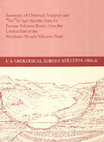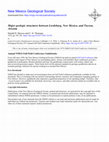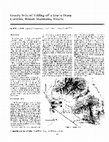Papers by Charles Thorman

Widespread rhyolitic to andesitic calc-alkaline volcanic rocks in northeast Nevada and northwest ... more Widespread rhyolitic to andesitic calc-alkaline volcanic rocks in northeast Nevada and northwest Utah are part of a distinct Eocene eruptive sequence that is older than previously believed. Parts of this volcanic terrane, the central part of the Northeast Nevada volcanic field, are exposed over a large area that extends in an east-west direction from the Silver Island Mountains, Utah, to Elko, Nevada, and in a north-south direction from an area a few miles north of Wells, Nevada, to the Deep Creek Range, Utah. The type area for the Northeast Nevada volcanic field is at Nanny Creek, in the northern Pequop Mountains, where the base of the volcanic sequence, unconformable on Eocene lacustrine deposits, includes rhyolitic ash-flow tuffs that are overlain by a monotonous series of dacitic to andesitic flows and flow breccias that were locally erupted. The similarities in age, chemistry, and mode of occurrence of these volcanic rocks throughout the field indicate that they are part of the same widespread Eocene volcanic sequence. Kl K2 EVOLUTION OF SEDIMENTARY BASINS EASTERN GREAT BASIN 40' Figure 1 (above and facing page). Map showing central part of Northeast Nevada volcanic field, northeast Nevada and adjacent Utah, composite stratigraphic column for Nanny Creek type area, and schematic west-east cross section of central part of Northeast Nevada volcanic field. A, Map showing localities (solid circles) from which Eocene volcanic rocks were dated and analyzed. Shaded areas indicate ranges. Samples from numbered localities were collected as part of this study:

Lithosphere, Jul 29, 2020
Mesozoic crustal shortening in the North American Cordillera's hinterland was related to the cons... more Mesozoic crustal shortening in the North American Cordillera's hinterland was related to the construction of the Nevadaplano orogenic plateau. Petrologic and geochemical proxies in Cordilleran core complexes suggest substantial Late Cretaceous crustal thickening during plateau construction. In eastern Nevada, geobarometry from the Snake Range and Ruby Mountains-East Humboldt Range-Wood Hills-Pequop Mountains (REWP) core complexes suggests that the~10-12 km thick Neoproterozoic-Triassic passive-margin sequence was buried to great depths (>30 km) during Mesozoic shortening and was later exhumed to the surface via high-magnitude Cenozoic extension. Deep regional burial is commonly reconciled with structural models involving cryptic thrust sheets, such as the hypothesized Windermere thrust in the REWP. We test the viability of deep thrust burial by examining the least-deformed part of the REWP in the Pequop Mountains. Observations include a compilation of new and published peak temperature estimates (n = 60) spanning the Neoproterozoic-Triassic strata, documentation of critical field relationships that constrain deformation style and timing, and new 40 Ar/ 39 Ar ages. This evidence refutes models of deep regional thrust burial, including (1) recognition that most contractional structures in the Pequop Mountains formed in the Jurassic, not Cretaceous, and (2) peak temperature constraints and field relationships are inconsistent with deep burial. Jurassic deformation recorded here correlates with coeval structures spanning western Nevada to central Utah, which highlights that Middle-Late Jurassic shortening was significant in the Cordilleran hinterland. These observations challenge commonly held views for the Mesozoic-early Cenozoic evolution of the REWP and Cordilleran hinterland, including the timing of contractional strain, temporal evolution of plateau growth, and initial conditions for high-magnitude Cenozoic extension. The long-standing differences between peak-pressure estimates and field relationships in Nevadan core complexes may reflect tectonic overpressure.

Geosphere, Oct 27, 2021
The Ruby Mountains-East Humboldt Range-Wood Hills-Pequop Mountains (REWP) meta morphic core compl... more The Ruby Mountains-East Humboldt Range-Wood Hills-Pequop Mountains (REWP) meta morphic core complex, northeast Nevada, exposes a record of Mesozoic contraction and Cenozoic extension in the hinterland of the North American Cordillera. The timing, magnitude, and style of crustal thickening and succeeding crustal thinning have long been debated. The Pequop Mountains, comprising Neoproterozoic through Triassic strata, are the least deformed part of this composite metamorphic core complex, compared to the migmatitic and mylonitized ranges to the west, and provide the clearest field relationships for the Mesozoic-Cenozoic tectonic evolution. New field, structural, geochronologic, and thermo chronological observations based on 1:24,000-scale geologic mapping of the northern Pequop Mountains provide insights into the multi-stage tectonic history of the REWP. Polyphase cooling and reheating of the middle-upper crust was tracked over the range of <100 °C to 450 °C via novel 40 Ar/ 39 Ar multi-diffusion domain modeling of muscovite and K-feldspar and apatite fission-track dating. Important new observations and interpretations include: (1) crosscutting field relationships show that most of the contractional deformation in this region occurred just prior to, or during, the Middle-Late Jurassic Elko orogeny (ca. 170-157 Ma), with negligible Cretaceous shortening; (2) temperature-depth data rule out deep burial of Paleozoic stratigraphy, thus refuting models that incorporate large cryptic overthrust sheets; (3) Jurassic, Cretaceous, and Eocene intrusions and associated thermal pulses metamorphosed the lower Paleozoic-Proterozoic rocks, and various thermochronometers record conductive cooling near original stratigraphic depths; (4) east-draining paleovalleys with ~1-1.5 km relief incised the region before ca. 41 Ma and were filled by 41-39.5 Ma volcanic rocks; and (5) low-angle normal faulting initiated after the Eocene, possibly as early as the late Oligocene, although basin-generating extension from high-angle normal faulting began in the middle Miocene. Observed Jurassic shortening is coeval with structures in the Luning-Fencemaker thrust belt to the west, and other strain documented across central-east Nevada and Utah, suggesting ~100 km Middle-Late Jurassic shortening across the Sierra Nevada retroarc. This phase of deformation correlates with terrane accretion in the Sierran forearc, increased North American-Farallon convergence rates, and enhanced Jurassic Sierran arc magmatism. Although spatially variable, the Cordilleran hinterland and the high plateau that developed across it (i.e., the hypothesized Nevadaplano) involved a dynamic pulsed evolution with significant phases of both Middle-Late Jurassic and Late Cretaceous contractional deformation. Collapse long postdated all of this contraction. This complex geologic history set the stage for the Carlin-type gold deposit at Long Canyon, located along the eastern flank of the Pequop Mountains, and may provide important clues for future exploration.
Journal of Geophysical Research, Aug 10, 1995
Abstracts with programs, 2019
GSA Annual Meeting in Denver, Colorado, USA - 2016, 2016

Earth and Planetary Science Letters, May 1, 1972
Abstract Hellas, a large circular area on the planet Mars, has been interpreted as a very old str... more Abstract Hellas, a large circular area on the planet Mars, has been interpreted as a very old structural basin, predating the formation of the cratered terrain of adjacent Hellespontus. Martian cratered terrain in turn has been interpreted as originating in large part during the final stages of planetary accretion. Previous suggestions concerning the relationships of craters to scarps and ridges and the antiquity of Hellas relative to the cratered terrain seem questionable. Scarps and ridges in the transition zone between Hellas and the cratered terrain both postdate and predate large craters. It appears to us that there are a number of craters which are older than the transition zone structures, which in turn are presumably related in some way to the formation of Hellas. Sharp et al. [1] have suggested impact, large-scale volcanic explosion, or subsidence for the origin of Hellas. Volcanic explosion seems the least likely explanation, for the resulting deficiency of mass beneath Hellas should induce later isostatic rebound, contrary to observations of the transition zone which imply subsidence relatively late in the history of the Martian surface. An origin of Hellas by impact with later isostatic subsidence (because of a dense mass under its floor, as suggested by Sharp et al.) to account for the characteristics of the transition zone seems to be the best model, and may also account for the featureless floor of the basin.

Geological Society of America, Abstracts with Programs; (United States), Apr 1, 1993
Lower Eocene White Sage Formation and upper Eocene volcanic rocks are used to date Mesozoic to mi... more Lower Eocene White Sage Formation and upper Eocene volcanic rocks are used to date Mesozoic to middle-Tertiary structures in and near the Goshute Indian Reservation, southern Deep Creek Range. Outcrops of conglomerate, limestone, and dolomite that are correlated with the White Sage type section at Gold Hill are scarce and confined to the eastern part of the map area. Voluminous volcanic rocks (39.5-- 39 Ma) are exposed in the western part of the map area. The relationships between these structures and the lower and upper Eocene rocks indicate that the attenuation faults are Paleocene or older, the broad folds are early to late Eocene, and the high-angle faults are post-late Eocene. Low-angle attenuation faults are most prominent at the Pennsylvanian Ely Limestone-Mississippian Chainman Shale contact, at the Mississippian-Devonian Pilot Shale-Devonian Guilmette Formation contact, and at the top of the Ordovician Eureka Quartzite. The White Sage overlies an attenuated section of Pilot Shale and Guilmette, establishing that the faults are pre-early Eocene. Deposition of White Sage on both Pennsylvanian and Devonian rocks indicates that by early Eocene time the attenuated Paleozoic rocks had been deeply eroded. Broad, N-NE-trending folds deform the White Sage and older rocks but are overlain unconformably bymore » a 39.5-Ma basal tuff, restricting the age of folding to the middle Eocene. Deformation of this age has also been documented at Gold Hill and on the east side of the Elko Basin. Erosion followed folding and stripped the White Sage from most of the area. High-angle, down-to-the-west faults cut all Eocene rocks and are therefore younger than about 39 Ma. Near the southern boundary of the Reservation, the faults die out, and, where present, become near bedding-parallel in moderately to steeply dipping and thinly bedded rocks. These faults can be distinguished from the older attenuation faults by their association with numerous, small-scale, listic normal faults.« less

Every fall since 1950, the New Mexico Geological Society (NMGS) has held an annual Fall Field Con... more Every fall since 1950, the New Mexico Geological Society (NMGS) has held an annual Fall Field Conference that explores some region of New Mexico (or surrounding states). Always well attended, these conferences provide a guidebook to participants. Besides detailed road logs, the guidebooks contain many well written, edited, and peer-reviewed geoscience papers. These books have set the national standard for geologic guidebooks and are an essential geologic reference for anyone working in or around New Mexico. Free Downloads NMGS has decided to make peer-reviewed papers from our Fall Field Conference guidebooks available for free download. This is in keeping with our mission of promoting interest, research, and cooperation regarding geology in New Mexico. However, guidebook sales represent a significant proportion of our operating budget. Therefore, only research papers are available for download. Road logs, mini-papers, and other selected content are available only in print for recent guidebooks. Copyright Information Publications of the New Mexico Geological Society, printed and electronic, are protected by the copyright laws of the United States. No material from the NMGS website, or printed and electronic publications, may be reprinted or redistributed without NMGS permission. Contact us for permission to reprint portions of any of our publications. One printed copy of any materials from the NMGS website or our print and electronic publications may be made for individual use without our permission. Teachers and students may make unlimited copies for educational use. Any other use of these materials requires explicit permission. This page is intentionally left blank to maintain order of facing pages.

Every fall since 1950, the New Mexico Geological Society (NMGS) has held an annual Fall Field Con... more Every fall since 1950, the New Mexico Geological Society (NMGS) has held an annual Fall Field Conference that explores some region of New Mexico (or surrounding states). Always well attended, these conferences provide a guidebook to participants. Besides detailed road logs, the guidebooks contain many well written, edited, and peer-reviewed geoscience papers. These books have set the national standard for geologic guidebooks and are an essential geologic reference for anyone working in or around New Mexico. Free Downloads NMGS has decided to make peer-reviewed papers from our Fall Field Conference guidebooks available for free download. Non-members will have access to guidebook papers two years after publication. Members have access to all papers. This is in keeping with our mission of promoting interest, research, and cooperation regarding geology in New Mexico. However, guidebook sales represent a significant proportion of our operating budget. Therefore, only research papers are available for download. Road logs, mini-papers, maps, stratigraphic charts, and other selected content are available only in the printed guidebooks. Copyright Information Publications of the New Mexico Geological Society, printed and electronic, are protected by the copyright laws of the United States. No material from the NMGS website, or printed and electronic publications, may be reprinted or redistributed without NMGS permission. Contact us for permission to reprint portions of any of our publications. One printed copy of any materials from the NMGS website or our print and electronic publications may be made for individual use without our permission. Teachers and students may make unlimited copies for educational use. Any other use of these materials requires explicit permission. This page is intentionally left blank to maintain order of facing pages.
International Geology Review, Jun 1, 1994
... All rights reserved. Geology and Mineral Resources of Brazil: A Review INACIO DEMEDEIROS DELG... more ... All rights reserved. Geology and Mineral Resources of Brazil: A Review INACIO DEMEDEIROS DELGADO, AUGUSTO J. PEDREIRA, Companhia de Pesquisa de Recursos Minerals, Scdvador, Bahia, Brazil AND CHARLES H. THORMAN US. ...
Petroleum, natural gas, limestone, dolomite, sandstone, clay, and sand and gravel have been produ... more Petroleum, natural gas, limestone, dolomite, sandstone, clay, and sand and gravel have been produced commercially on the Osage Indian Reservation. Production of these commodities will probably continue, but sandstone may be produced only in minor quantities. Potential exists for producing dolomite, and possibly limestone, for chemical and metallurgical purposes although all limestone and dolomite production to date has been used for crushed stone. Clay deposits on the reservation have been used as a source of materials for brick manufacture; how ever, some clay occurring on Indian land is suitable for artware as well as structural clay products.

Geological Society of America Bulletin, 1977
Detached isoclinal folds, overturned asymmetric folds, and unbroken cascades of recumbent folds p... more Detached isoclinal folds, overturned asymmetric folds, and unbroken cascades of recumbent folds pervade sheets of sedimentary and metasedimentary rocks of Paleozoic and Mesozoic age that occur around the base of the Rincon Mountains near Tucson, Arizona. The sheets of folded rocks rest subconcordantly on the gently dipping surface of the granitic gneiss that composes much of the range. This surface, known as the Catalina fault, parallels the attitude of the foliation in the gneiss and is folded about two macroscopic upright antiforms and an intervening synform. The low-angle tectonic displacement reflected in the folds was brought about by local gravitational tectonics. The slip-line directions inferred from the geometry of the fold arrays define a radial pattern centered on the Rincon Mountains. The forms of the folds are consistent with the characteristics of gravity-induced folds. Most of the gravity-induced folding is interpreted to have accompanied the 28-to 24-m.y. uplift that ended the Tertiary metamorphism of gneiss in the Rincon Mountain complex. The Catalina fault is interpreted to be a décollement, above which the sedimentary and metasedimentary rocks folded independently of their substratum.

Geological Society of America Bulletin, 1970
The Wood Hills and Pequop Mountains of northeastern Nevada are located within the Cordilleran mio... more The Wood Hills and Pequop Mountains of northeastern Nevada are located within the Cordilleran miogeosyncline of Paleozoic age and in the Basin and Range province of Cenozoic age. Two structural units or plates, designated Plates I and II, are juxtaposed along the Wood Hills thrust and underlie the area. Plate II overlies Plate I in both ranges and contains nonmetamorphosed Paleozoic carbonates and clastics ranging from Early Ordovician through Middle Permian in age and exceeding 15,000 ft in thickness. Within Plate II are two stratigraphically different tectonic units that have been juxtaposed along the Wells fault, a major east-southeast-trending transcurrent fault with possibly 40 mi of right slip. Rocks typical of the western portion of the miogeosyncline—Roberts Mountains Formation (Silurian)—occur north of the fault, whereas rocks typical of the eastern portion—Laketown Dolomite (Silurian)—occur south of the fault. In contrast to the upper structural unit (Plate II), Plate I consists of regionally metamorphosed Cambrian through Devonian miogeosynclinal strata. Metamorphism produced banded tectonitic marble, micaceous marble, schist, and metaquartzite. Though the rocks have undergone considerable deformation, the metamorphosed succession can be correlated almost member by member with Plate II strata. This correlation is based on stratigraphic sequence and fossils preserved locally in the meta-sedimentary rocks. The metamorphism occurred in two phases, a synkinematic phase that attained the kyanite-staurolite zone, followed by a post kinematic phase interpreted as a record of continued recrystallization after penetrative deformation had ended. During Jurassic-Cretaceous time, the area was subjected to several episodes of orogenesis, beginning with regional metamorphism and ending with large-scale thrusting. Depth of burial during metamorphism for kyanite-bearing rocks of Plate I in the Wood Hills may have been about 5 to 6 mi. Following metamorphism, the Paleozoic succession, both metamorphosed and nonmetamorphosed, was apparently thrust northwestward over Precambrian crystalline rocks, developing large overturned folds in the metamorphic rocks. Subsequently, the non metamorphic rocks (Plate II) were sheared off from the underlying metamorphic rocks (Plate I) along the Wood Hills thrust and moved east to southeast, truncating previously formed structures in the metamorphic rocks; displacement may be as much as 20 to 30 mi or only 5 to 10 mi. While attaining its present position, Plate II was broken up into several smaller structural subdivisions. The Wood Hills thrust represents the regional decollement zone that Misch (1960) considers to be present throughout most or all of the central-eastern Nevada portion of the Great Basin. During the Cenozoic the area underwent intermittent erosion and deposition until Mio-Pliocene? time, when considerable local relief was developed, so that landslide deposits accumulated on both Plates I and II in the Wood Hills. Tertiary volcanic rocks occur in the Pequop Mountains predating range uplift. Sometime during the Cenozoic, possibly before the events referred to above, two north-trending domes formed, one centered under the Wood Hills, and the other, just west of the Pequop Mountains. Uplift of the Wood Hills appears to have occurred without major faulting, whereas the Pequop Mountains is an east-tilted fault block that includes the eastern half of a dome.










Uploads
Papers by Charles Thorman